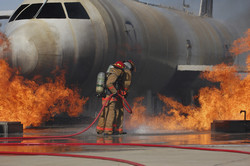Fire-resistant composite materials
Composite materials, consisting of reinforced carbon or glass fibres in an organic resin matrix, are an established technology for producing lightweight structures in aerospace and other transport sectors. However, they can decompose and collapse in a fire, releasing smoke and toxic chemicals as well as heat. The EU-funded project FIRE-RESIST (Developing novel fire-resistant high performance composites) was initiated to develop solutions for enhancing their fire performance. The project consortium of 18 partners brought together experiences and requirements from the aerospace, railway and maritime industries. Project work entailed fundamental research to better understand the performance of composite materials under high-temperature conditions. In total, six new polymer composites were optimised, including a furan resin combined with cork agglomeration. This material fulfilled fire resistance requirements for wall, ceiling and floor coverings. Besides fire-resistant polymer resins, investigation into new formulations of composite materials centred on multilayer metallic laminates and co-mingling technology. Co-mingling involves the formation of fibre reinforcement mats from a mixture of glass and polymeric fibres. The mat is then placed in a mould where pressure and heat are applied. The most promising new materials were used in case study components, designed and prototyped for railway, aerospace and maritime applications. These components were subjected to fire tests and the performance of the FIRE-RESIST materials validated. The behaviour of structural elements in a fire was analysed with respect to heat transfer and deflection as well as heat load-bearing capacity. In addition, project researchers developed a dedicated framework for numerical simulations of polymer composite materials and thermomechanical analysis. Numerical simulations combined computational fluid dynamics modelling of fire, flames and thermal radiation with finite element analysis of structural responses. By working towards improving the fire resistance of composite materials without compromising their structural performance, FIRE-RESIST has made a valuable contribution to greater passenger safety. The new technology is also expected to lower fuel consumption and carbon dioxide emissions while enhancing the European industry's competitiveness.
Keywords
Fire-resistant, polymer composites, transport, furan resin, metallic laminates, fibre reinforcement







